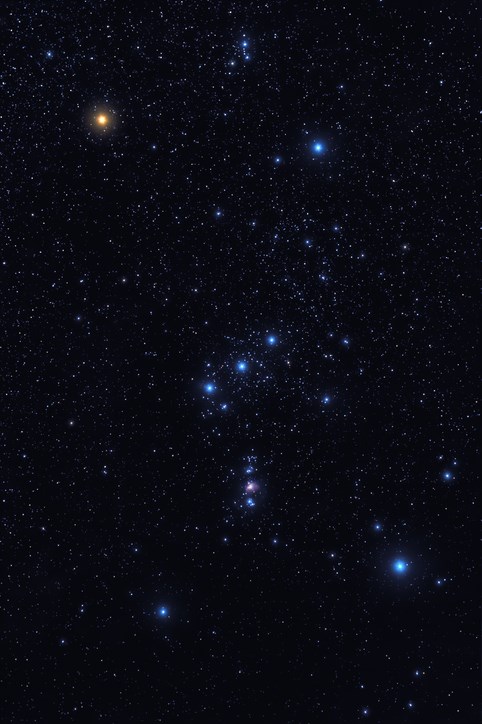I covered the bright massive stars Betelgeuse and Rigel at the upper left and lower right corners of Orion in my last article. At the upper right is another bright blue-white star named Bellatrix. The name is apparently Latin in origin and was used for the star Capella until the fifteenth century when it was transferred to what is now Bellatrix. Bellatrix is located approximately 240 light-years away – much closer than Betelgeuse and Rigel. It’s about eight solar masses and about six times the diameter and is likely about 25 million years old. It seems to be in the process of starting to fuse helium in its core and expanding to a giant phase.
Consequently, its luminosity has grown to about 10,000 times that of the sun and its temperature is about 22,000K compared to our sun’s 6,000K. I have seen contradictory claims that it is / isn’t a spectroscopic binary system; as well, its mass puts it right at the lower range of stars that will likely end as supernovae. If not, it will blow off its outer atmosphere into a planetary nebula and wind up as a massive white dwarf.
Next is Saiph at the lower left corner. It’s another blue giant star, similar to Rigel but about 75 per cent of its mass and a few million years older. It’s about 20 times the size of our Sun and about 60,000 times as luminous. Like Betelgeuse and Rigel, it’s destined to go supernova within a few million years. Our own star – a nice, medium-small and stable G class star – is already about 4,500 million years old with another 5,000 million years to go before the wheels come off. By comparison the stars in Orion are definitely living life in the fast lane!
The striking row of three bright blue-white stars in the middle is known as Orion’s Belt. They’re all similar apparent magnitude and are hot blue O and B spectral types. From east to west (or left to right in the Northern Hemisphere) their names are: Alnitak, Alnilam and Mintaka. Now it gets interesting: Alnitak (left) is actually a triple system; the first, Alnitak A is actually a close binary pair. Aa is a blue supergiant and the brightest class O star in the sky. Its mass is 33 times the sun’s and its radius 20 times. Its companion, Ab is a blue subgiant that orbits Aa about ten times farther than we are from our sun, too close to be resolved visually. The other star, Alnitak B, is a blue class B giant which orbits Aa and Ab every 1,500 years or so and which can be resolved with a telescope.
The middle star, Alnilam, is a blue-white supergiant star of spectral type B, about 40 times more massive than the sun and a radius 32.4 times the sun’s. Its estimated luminosity range is between 275,000 and 832,000 times that of the sun. It’s estimated to be only a few million years old and will share the fate of its neighbours in ending its life as a supernova. While Alnitak and Mintaka are both 800 to 900 lightyears away, Alnilam is almost 2,000 lightyears distant.
The right star, Mintaka, is actually a triple star system with a close companion that may or not be gravitationally bound. The bright three orbit in a plane edge-on to us, so they regularly eclipse each other, which makes it interesting. The closest pair apparently orbit each other in only 5.73 days; they’re a class O bright giant and a class B main sequence star. One useful feature of Orion’s Belt is that if you follow the line eastward it points generally to the brightest star in our sky, Sirius.
Below Orion’s Belt is the Sword asterism. It’s not as striking as the Belt but more interesting nonetheless. Most people see it as a short line of three stars except that the middle “star” looks fuzzy. As one’s eyes become totally dark-adapted, you realize it IS fuzzy. Then, when you get the binoculars or a small telescope on it, you see it’s actually a small cluster of stars, very close together and with a faint glow surrounding them. This is the Great Nebula of Orion a.k.a. Messier 42 or NGC 1976, a giant cloud of gas and dust about 1,300 lightyears from Earth and the brightest in the northern hemisphere. The cluster of bright stars in the center has been named the Trapezium and the gas and dust clouds glow from reflection and from fluorescence due to ultraviolet radiation from the stars. The entire nebula is also acting as a stellar nursery with many new stars visible by infrared within their collapsing mantles of dust and gas. I have read that this nebula complex and all it contains is the most highly-studied area in the sky and I’m quite prepared to believe it. Check out the archive list on the Astronomy Picture of the Day site (APOD) at apod.nasa.gov/apod/astropix.html and you’ll find beautiful photos of most of the stars and objects I’ve mentioned.
The club website at: sunshinecoastastronomy.wordpress.com/ will have information on the speaker and topic and how to register for the meeting the week prior.



